Abstract
The cysteine proteinase 1 and 2 mRNA sequences of Dictyostelium discoideum encode proteins with a high degree of homology to plant and animal sulphydryl proteinases. The two mRNA sequences are co-ordinate in their regulation, both being first expressed late during cellular aggregation, prematurely induced in response to exogenous cAMP and several-fold enriched in prestalk over prespore cells. The two proteins are considerably diverged, with only 43% overall homology but all residues known to be important in catalysis are conserved and both contain a hydrophobic leader peptide which forms part of an N-terminal domain of just over 100 amino acids not found in the mature form of known cysteine proteinases. We have determined the sequence organization of both genes and find differences both in the number and position of introns. The close co-regulation of these two genes suggests that they may play a common role in Dictyostelium development, presumably in the autodigestion of cellular protein which occurs during differentiation. However, the low degree of sequence homology and major differences in gene organization indicate that they have undergone a considerable period of separate evolution and that they may differ in their precise function.
Full text
PDF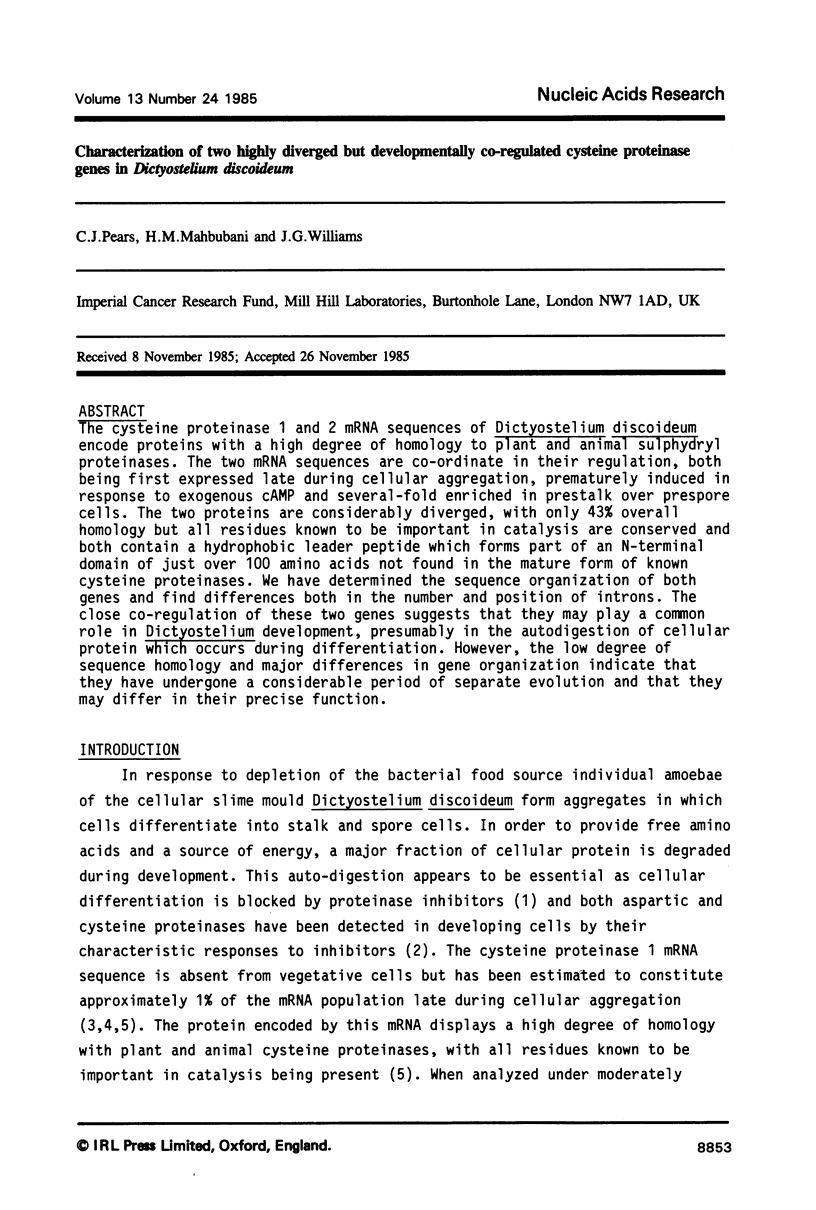


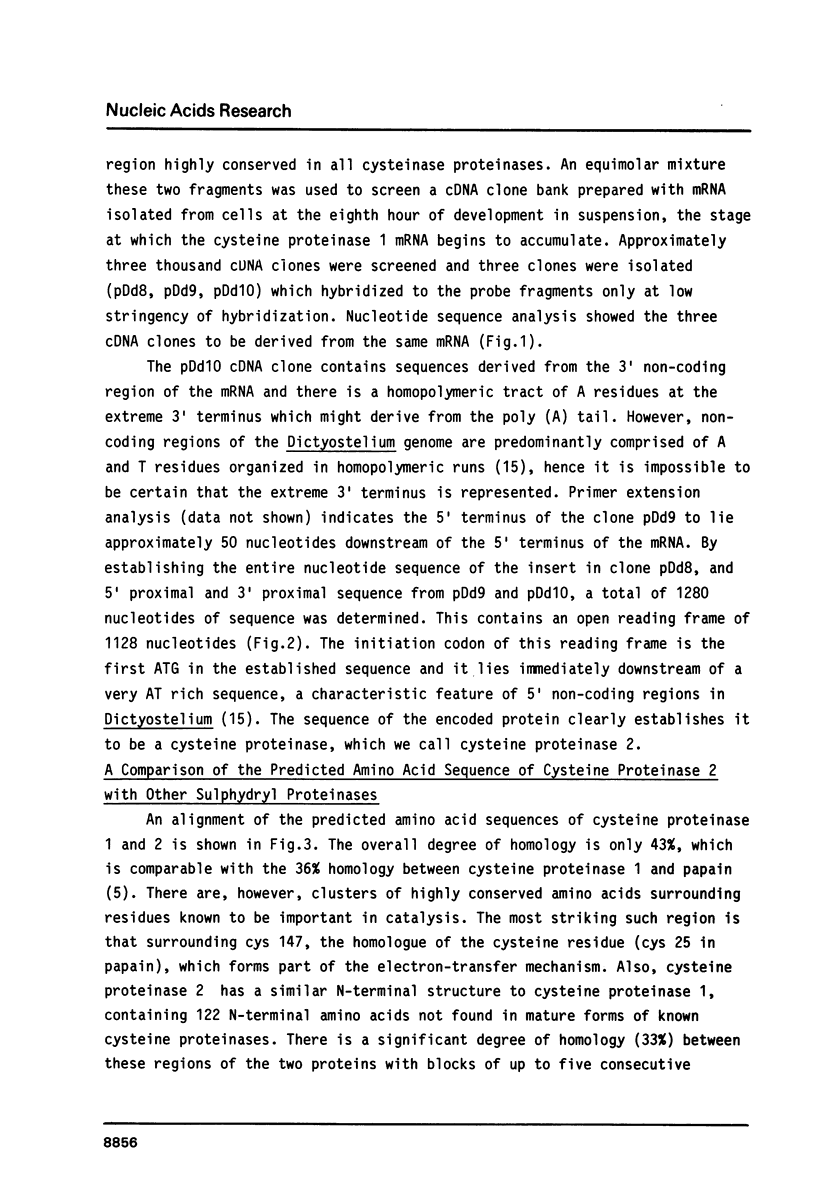
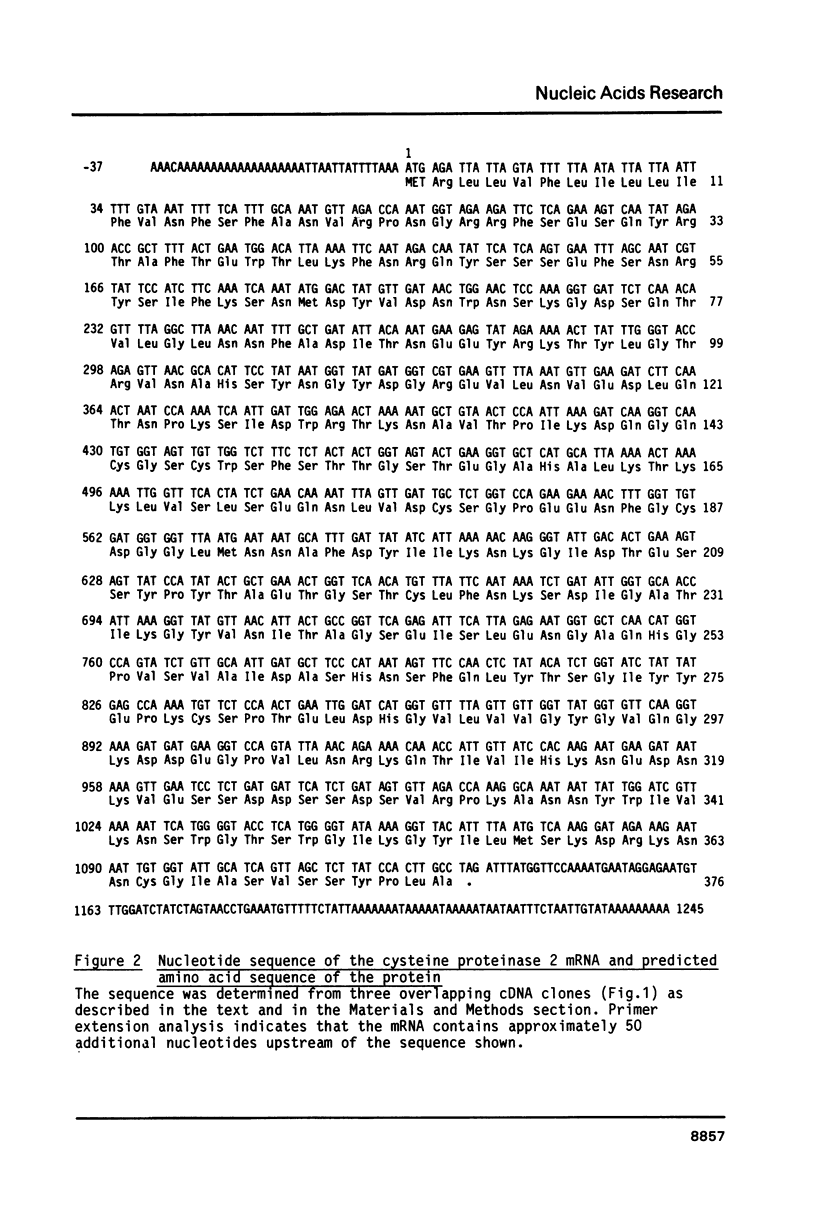
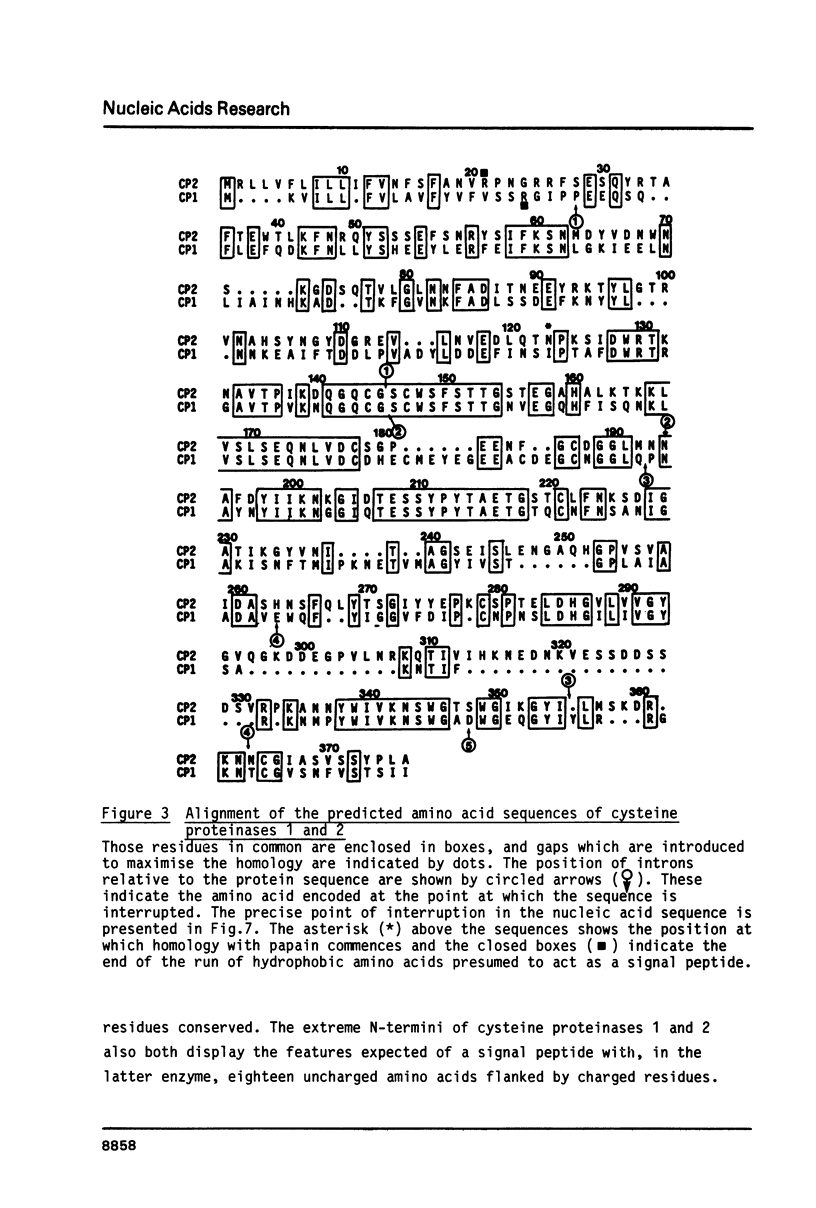





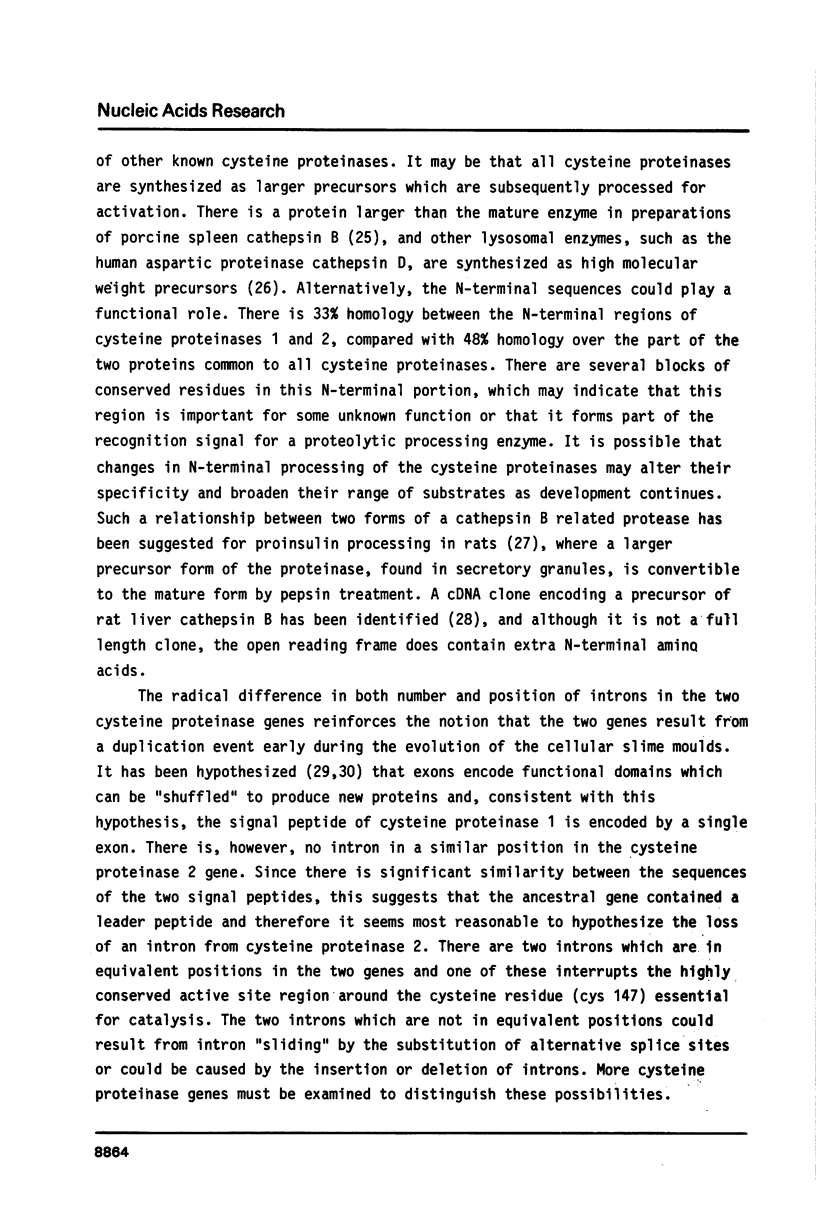

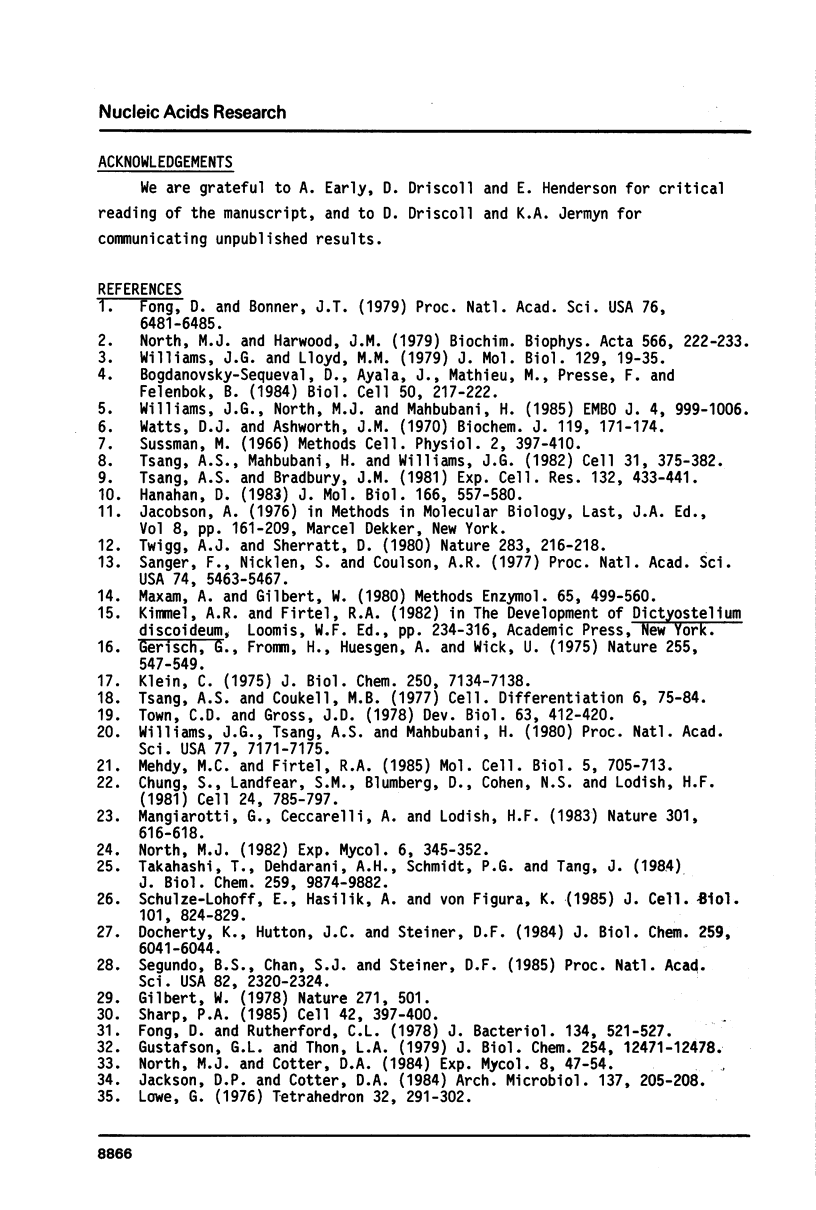
Images in this article
Selected References
These references are in PubMed. This may not be the complete list of references from this article.
- Chung S., Landfear S. M., Blumberg D. D., Cohen N. S., Lodish H. F. Synthesis and stability of developmentally regulated dictyostelium mRNAs are affected by cell--cell contact and cAMP. Cell. 1981 Jun;24(3):785–797. doi: 10.1016/0092-8674(81)90104-5. [DOI] [PubMed] [Google Scholar]
- Docherty K., Hutton J. C., Steiner D. F. Cathepsin B-related proteases in the insulin secretory granule. J Biol Chem. 1984 May 25;259(10):6041–6044. [PubMed] [Google Scholar]
- Fong D., Bonner J. T. Proteases in cellular slime mold development: evidence for their involvement. Proc Natl Acad Sci U S A. 1979 Dec;76(12):6481–6485. doi: 10.1073/pnas.76.12.6481. [DOI] [PMC free article] [PubMed] [Google Scholar]
- Fong D., Rutherford C. L. Protease activity during cell differentiation of the cellular slime mold Dictyostelium discoideum. J Bacteriol. 1978 May;134(2):521–527. doi: 10.1128/jb.134.2.521-527.1978. [DOI] [PMC free article] [PubMed] [Google Scholar]
- Gerisch G., Fromm H., Huesgen A., Wick U. Control of cell-contact sites by cyclic AMP pulses in differentiating Dictyostelium cells. Nature. 1975 Jun 12;255(5509):547–549. doi: 10.1038/255547a0. [DOI] [PubMed] [Google Scholar]
- Gilbert W. Why genes in pieces? Nature. 1978 Feb 9;271(5645):501–501. doi: 10.1038/271501a0. [DOI] [PubMed] [Google Scholar]
- Gustafson G. L., Thon L. A. Purification and characterization of a proteinase from Dictyostelium discoideum. J Biol Chem. 1979 Dec 25;254(24):12471–12478. [PubMed] [Google Scholar]
- Hanahan D. Studies on transformation of Escherichia coli with plasmids. J Mol Biol. 1983 Jun 5;166(4):557–580. doi: 10.1016/s0022-2836(83)80284-8. [DOI] [PubMed] [Google Scholar]
- Klein C. Induction of phosphodiesterase by cyclic adenosine 3':5'-monophosphate in differentiating Dictyostelium discoideum amoebae. J Biol Chem. 1975 Sep 25;250(18):7134–7138. [PubMed] [Google Scholar]
- Mangiarotti G., Ceccarelli A., Lodish H. F. Cyclic AMP stabilizes a class of developmentally regulated Dictyostelium discoideum mRNAs. Nature. 1983 Feb 17;301(5901):616–618. doi: 10.1038/301616a0. [DOI] [PubMed] [Google Scholar]
- Maxam A. M., Gilbert W. Sequencing end-labeled DNA with base-specific chemical cleavages. Methods Enzymol. 1980;65(1):499–560. doi: 10.1016/s0076-6879(80)65059-9. [DOI] [PubMed] [Google Scholar]
- Mehdy M. C., Firtel R. A. A secreted factor and cyclic AMP jointly regulate cell-type-specific gene expression in Dictyostelium discoideum. Mol Cell Biol. 1985 Apr;5(4):705–713. doi: 10.1128/mcb.5.4.705. [DOI] [PMC free article] [PubMed] [Google Scholar]
- North M. J., Harwood J. M. Multiple acid proteinases in the cellular slime mould Dictyostelium discoideum. Biochim Biophys Acta. 1979 Jan 12;566(1):222–233. doi: 10.1016/0005-2744(79)90264-x. [DOI] [PubMed] [Google Scholar]
- San Segundo B., Chan S. J., Steiner D. F. Identification of cDNA clones encoding a precursor of rat liver cathepsin B. Proc Natl Acad Sci U S A. 1985 Apr;82(8):2320–2324. doi: 10.1073/pnas.82.8.2320. [DOI] [PMC free article] [PubMed] [Google Scholar]
- Sanger F., Nicklen S., Coulson A. R. DNA sequencing with chain-terminating inhibitors. Proc Natl Acad Sci U S A. 1977 Dec;74(12):5463–5467. doi: 10.1073/pnas.74.12.5463. [DOI] [PMC free article] [PubMed] [Google Scholar]
- Schulze-Lohoff E., Hasilik A., von Figura K. Cathepsin D precursors in clathrin-coated organelles from human fibroblasts. J Cell Biol. 1985 Sep;101(3):824–829. doi: 10.1083/jcb.101.3.824. [DOI] [PMC free article] [PubMed] [Google Scholar]
- Sharp P. A. On the origin of RNA splicing and introns. Cell. 1985 Sep;42(2):397–400. doi: 10.1016/0092-8674(85)90092-3. [DOI] [PubMed] [Google Scholar]
- Takahashi T., Dehdarani A. H., Schmidt P. G., Tang J. Cathepsins B and H from porcine spleen. Purification, polypeptide chain arrangements, and carbohydrate content. J Biol Chem. 1984 Aug 10;259(15):9874–9882. [PubMed] [Google Scholar]
- Town C., Gross J. The role of cyclic nucleotides and cell agglomeration in postaggregative enzyme synthesis in Dictyostelium discoideum. Dev Biol. 1978 Apr;63(2):412–420. doi: 10.1016/0012-1606(78)90145-8. [DOI] [PubMed] [Google Scholar]
- Tsang A. S., Mahbubani H., Williams J. G. Cell-type-specific actin mRNA populations in dictyostelium discoideum. Cell. 1982 Dec;31(2 Pt 1):375–382. doi: 10.1016/0092-8674(82)90131-3. [DOI] [PubMed] [Google Scholar]
- Tsang A., Bradbury J. M. Separation and properties of prestalk and prespore cells of Dictyostelium discoideum. Exp Cell Res. 1981 Apr;132(2):433–441. doi: 10.1016/0014-4827(81)90118-x. [DOI] [PubMed] [Google Scholar]
- Twigg A. J., Sherratt D. Trans-complementable copy-number mutants of plasmid ColE1. Nature. 1980 Jan 10;283(5743):216–218. doi: 10.1038/283216a0. [DOI] [PubMed] [Google Scholar]
- Watts D. J., Ashworth J. M. Growth of myxameobae of the cellular slime mould Dictyostelium discoideum in axenic culture. Biochem J. 1970 Sep;119(2):171–174. doi: 10.1042/bj1190171. [DOI] [PMC free article] [PubMed] [Google Scholar]
- Williams J. G., Lloyd M. M. Changes in the abundance of polyadenylated RNA during slime mould development measured using cloned molecular hybridization probes. J Mol Biol. 1979 Mar 25;129(1):19–35. doi: 10.1016/0022-2836(79)90056-1. [DOI] [PubMed] [Google Scholar]
- Williams J. G., North M. J., Mahbubani H. A developmentally regulated cysteine proteinase in Dictyostelium discoideum. EMBO J. 1985 Apr;4(4):999–1006. doi: 10.1002/j.1460-2075.1985.tb03730.x. [DOI] [PMC free article] [PubMed] [Google Scholar]
- Williams J. G., Tsang A. S., Mahbubani H. A change in the rate of transcription of a eukaryotic gene in response to cyclic AMP. Proc Natl Acad Sci U S A. 1980 Dec;77(12):7171–7175. doi: 10.1073/pnas.77.12.7171. [DOI] [PMC free article] [PubMed] [Google Scholar]




